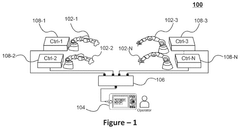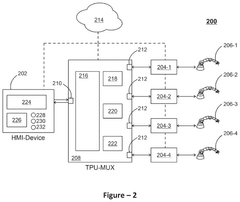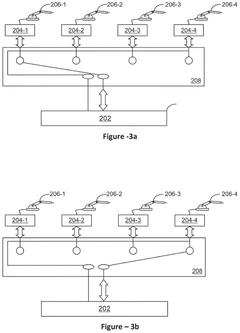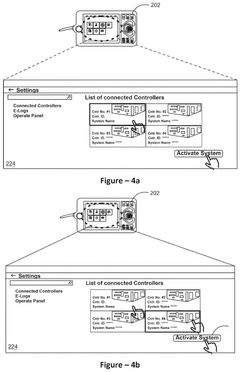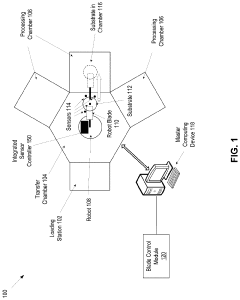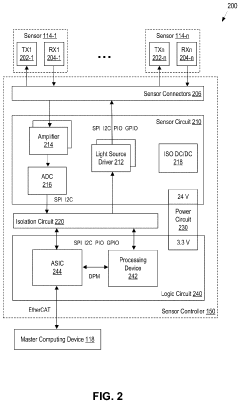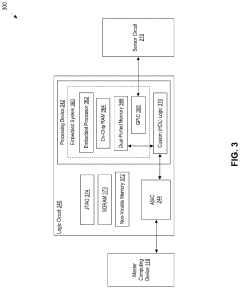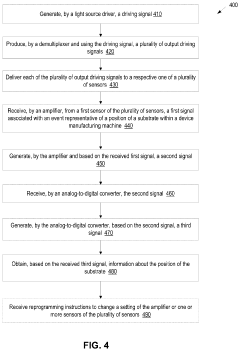Strategic Applications of Multiplexers in Modern Automation
JUL 13, 20259 MIN READ
Generate Your Research Report Instantly with AI Agent
Patsnap Eureka helps you evaluate technical feasibility & market potential.
Multiplexer Evolution
The evolution of multiplexers in modern automation has been a journey of continuous innovation and adaptation to meet the ever-increasing demands of complex control systems. Initially developed as simple signal selectors, multiplexers have transformed into sophisticated devices capable of handling multiple data streams simultaneously, playing a crucial role in the advancement of automation technologies.
In the early stages of automation, multiplexers were primarily used for basic signal routing in industrial control systems. These early devices were limited in their capacity and speed, often handling only a few analog or digital inputs. As automation systems grew more complex, the need for more efficient data management became apparent, driving the development of more advanced multiplexer designs.
The advent of digital technology in the 1970s and 1980s marked a significant turning point in multiplexer evolution. This era saw the introduction of integrated circuit-based multiplexers, which offered improved performance, reduced size, and increased reliability. These advancements enabled the integration of multiplexers into a wider range of automation applications, from process control to telecommunications.
The 1990s and early 2000s witnessed a surge in the capabilities of multiplexers, driven by the rapid growth of computer networks and data communication systems. This period saw the development of high-speed multiplexers capable of handling multiple gigabits of data per second, essential for managing the increasing data flow in modern automated systems.
Recent years have seen a shift towards intelligent multiplexing systems that incorporate advanced features such as self-diagnostics, adaptive routing, and real-time reconfiguration. These smart multiplexers are capable of optimizing data flow based on network conditions and system requirements, significantly enhancing the efficiency and flexibility of automation systems.
The integration of multiplexers with other emerging technologies has further expanded their capabilities. For instance, the combination of multiplexers with software-defined networking (SDN) has led to more dynamic and programmable data routing in industrial networks. Similarly, the incorporation of artificial intelligence and machine learning algorithms has enabled predictive maintenance and adaptive performance optimization in multiplexer-based systems.
Looking ahead, the evolution of multiplexers in automation is likely to continue along several key trajectories. One significant trend is the development of even more compact and energy-efficient multiplexers to support the growing Internet of Things (IoT) ecosystem in industrial settings. Additionally, there is a push towards higher bandwidth capacities to accommodate the increasing data demands of Industry 4.0 initiatives and advanced manufacturing processes.
In the early stages of automation, multiplexers were primarily used for basic signal routing in industrial control systems. These early devices were limited in their capacity and speed, often handling only a few analog or digital inputs. As automation systems grew more complex, the need for more efficient data management became apparent, driving the development of more advanced multiplexer designs.
The advent of digital technology in the 1970s and 1980s marked a significant turning point in multiplexer evolution. This era saw the introduction of integrated circuit-based multiplexers, which offered improved performance, reduced size, and increased reliability. These advancements enabled the integration of multiplexers into a wider range of automation applications, from process control to telecommunications.
The 1990s and early 2000s witnessed a surge in the capabilities of multiplexers, driven by the rapid growth of computer networks and data communication systems. This period saw the development of high-speed multiplexers capable of handling multiple gigabits of data per second, essential for managing the increasing data flow in modern automated systems.
Recent years have seen a shift towards intelligent multiplexing systems that incorporate advanced features such as self-diagnostics, adaptive routing, and real-time reconfiguration. These smart multiplexers are capable of optimizing data flow based on network conditions and system requirements, significantly enhancing the efficiency and flexibility of automation systems.
The integration of multiplexers with other emerging technologies has further expanded their capabilities. For instance, the combination of multiplexers with software-defined networking (SDN) has led to more dynamic and programmable data routing in industrial networks. Similarly, the incorporation of artificial intelligence and machine learning algorithms has enabled predictive maintenance and adaptive performance optimization in multiplexer-based systems.
Looking ahead, the evolution of multiplexers in automation is likely to continue along several key trajectories. One significant trend is the development of even more compact and energy-efficient multiplexers to support the growing Internet of Things (IoT) ecosystem in industrial settings. Additionally, there is a push towards higher bandwidth capacities to accommodate the increasing data demands of Industry 4.0 initiatives and advanced manufacturing processes.
Automation Market Trends
The automation market is experiencing significant growth and transformation, driven by the increasing demand for efficiency, productivity, and cost reduction across various industries. This trend is particularly evident in the manufacturing sector, where Industry 4.0 initiatives are pushing for greater integration of smart technologies and interconnected systems. The global automation market size was valued at $191.89 billion in 2021 and is projected to reach $395.09 billion by 2029, growing at a CAGR of 9.8% during the forecast period.
One of the key factors fueling this growth is the rising adoption of Industrial Internet of Things (IIoT) technologies. IIoT enables seamless communication between machines, devices, and systems, leading to improved operational efficiency and real-time decision-making capabilities. This trend is closely aligned with the increasing implementation of multiplexers in automation systems, as they play a crucial role in managing and optimizing data flow within complex networks.
The automotive industry is emerging as a significant driver of automation market growth, with a focus on developing autonomous vehicles and smart manufacturing processes. This sector's automation spending is expected to grow at a CAGR of 11.7% through 2025, creating new opportunities for multiplexer applications in vehicle control systems and production line optimization.
Another notable trend is the growing emphasis on energy efficiency and sustainability in industrial operations. This has led to increased adoption of smart grid technologies and building automation systems, both of which rely heavily on multiplexing techniques for efficient data transmission and management. The building automation market alone is projected to reach $273.29 billion by 2028, with a CAGR of 10.7% from 2021 to 2028.
The healthcare sector is also witnessing rapid automation adoption, particularly in the wake of the COVID-19 pandemic. Telemedicine, remote patient monitoring, and automated diagnostic systems are becoming increasingly prevalent, creating new avenues for multiplexer applications in medical devices and healthcare IT infrastructure.
As automation technologies continue to evolve, there is a growing demand for more sophisticated and flexible multiplexing solutions. This includes the development of software-defined networking (SDN) and network function virtualization (NFV) technologies, which are reshaping the way data is managed and transmitted in automated systems. These advancements are expected to drive innovation in multiplexer design and functionality, further enhancing their strategic importance in modern automation landscapes.
One of the key factors fueling this growth is the rising adoption of Industrial Internet of Things (IIoT) technologies. IIoT enables seamless communication between machines, devices, and systems, leading to improved operational efficiency and real-time decision-making capabilities. This trend is closely aligned with the increasing implementation of multiplexers in automation systems, as they play a crucial role in managing and optimizing data flow within complex networks.
The automotive industry is emerging as a significant driver of automation market growth, with a focus on developing autonomous vehicles and smart manufacturing processes. This sector's automation spending is expected to grow at a CAGR of 11.7% through 2025, creating new opportunities for multiplexer applications in vehicle control systems and production line optimization.
Another notable trend is the growing emphasis on energy efficiency and sustainability in industrial operations. This has led to increased adoption of smart grid technologies and building automation systems, both of which rely heavily on multiplexing techniques for efficient data transmission and management. The building automation market alone is projected to reach $273.29 billion by 2028, with a CAGR of 10.7% from 2021 to 2028.
The healthcare sector is also witnessing rapid automation adoption, particularly in the wake of the COVID-19 pandemic. Telemedicine, remote patient monitoring, and automated diagnostic systems are becoming increasingly prevalent, creating new avenues for multiplexer applications in medical devices and healthcare IT infrastructure.
As automation technologies continue to evolve, there is a growing demand for more sophisticated and flexible multiplexing solutions. This includes the development of software-defined networking (SDN) and network function virtualization (NFV) technologies, which are reshaping the way data is managed and transmitted in automated systems. These advancements are expected to drive innovation in multiplexer design and functionality, further enhancing their strategic importance in modern automation landscapes.
Multiplexer Challenges
While multiplexers have revolutionized modern automation systems, they face several significant challenges that impact their performance and widespread adoption. One of the primary issues is signal integrity degradation, particularly in high-frequency applications. As data rates increase, maintaining signal quality becomes increasingly difficult due to factors such as crosstalk, electromagnetic interference, and signal attenuation. This challenge is especially pronounced in complex automation environments where multiple signals must be transmitted over long distances.
Another critical challenge is power consumption. As automation systems grow more sophisticated, the number of multiplexers required increases, leading to higher overall power demands. This not only impacts energy efficiency but also raises concerns about heat dissipation in compact automation setups. Balancing power consumption with performance is a constant struggle for designers and engineers working with multiplexers in automation applications.
Scalability presents another hurdle for multiplexer implementation. As industrial processes become more complex, the need for handling a greater number of input and output channels grows. However, increasing the number of channels often leads to increased complexity in multiplexer design, potentially affecting reliability and maintenance requirements. This scalability challenge is particularly evident in large-scale automation projects where thousands of sensors and actuators need to be managed efficiently.
Latency is a critical concern in real-time automation systems. While multiplexers can efficiently manage multiple signals, the process of multiplexing and demultiplexing introduces inherent delays. In time-sensitive applications, such as high-speed manufacturing or process control, even microsecond delays can have significant impacts on system performance and product quality. Minimizing latency while maintaining signal integrity and channel capacity is an ongoing challenge for multiplexer designers.
Compatibility and standardization issues also pose challenges in the implementation of multiplexers across diverse automation platforms. Different industries and applications often have varying requirements and protocols, making it difficult to develop universal multiplexer solutions. This lack of standardization can lead to integration problems when combining equipment from multiple vendors or upgrading existing systems.
Lastly, the increasing demand for cybersecurity in industrial automation presents new challenges for multiplexer design and implementation. As multiplexers handle critical data streams, ensuring the security and integrity of these signals becomes paramount. Protecting against unauthorized access, data manipulation, and other cyber threats while maintaining the high-speed, low-latency performance required in automation applications is a complex and evolving challenge.
Another critical challenge is power consumption. As automation systems grow more sophisticated, the number of multiplexers required increases, leading to higher overall power demands. This not only impacts energy efficiency but also raises concerns about heat dissipation in compact automation setups. Balancing power consumption with performance is a constant struggle for designers and engineers working with multiplexers in automation applications.
Scalability presents another hurdle for multiplexer implementation. As industrial processes become more complex, the need for handling a greater number of input and output channels grows. However, increasing the number of channels often leads to increased complexity in multiplexer design, potentially affecting reliability and maintenance requirements. This scalability challenge is particularly evident in large-scale automation projects where thousands of sensors and actuators need to be managed efficiently.
Latency is a critical concern in real-time automation systems. While multiplexers can efficiently manage multiple signals, the process of multiplexing and demultiplexing introduces inherent delays. In time-sensitive applications, such as high-speed manufacturing or process control, even microsecond delays can have significant impacts on system performance and product quality. Minimizing latency while maintaining signal integrity and channel capacity is an ongoing challenge for multiplexer designers.
Compatibility and standardization issues also pose challenges in the implementation of multiplexers across diverse automation platforms. Different industries and applications often have varying requirements and protocols, making it difficult to develop universal multiplexer solutions. This lack of standardization can lead to integration problems when combining equipment from multiple vendors or upgrading existing systems.
Lastly, the increasing demand for cybersecurity in industrial automation presents new challenges for multiplexer design and implementation. As multiplexers handle critical data streams, ensuring the security and integrity of these signals becomes paramount. Protecting against unauthorized access, data manipulation, and other cyber threats while maintaining the high-speed, low-latency performance required in automation applications is a complex and evolving challenge.
Current MUX Solutions
01 Design and implementation of multiplexer circuits
Multiplexers are fundamental components in digital circuit design, used to select one of several input signals and forward it to a single output. They are crucial in data routing, signal selection, and reducing pin count in integrated circuits. Various design techniques and implementations exist to optimize multiplexer performance, including speed, power consumption, and area efficiency.- Design and implementation of multiplexer circuits: Multiplexers are fundamental components in digital circuits used for selecting and routing data from multiple input sources to a single output. They are designed using logic gates and can be implemented in various configurations depending on the number of inputs and control signals. Advanced multiplexer designs may incorporate features like cascading for handling larger numbers of inputs or integrating with other circuit elements for enhanced functionality.
- Multiplexers in memory systems: Multiplexers play a crucial role in memory systems, particularly in addressing and data routing. They are used in memory controllers, cache systems, and memory interfaces to manage data flow between different memory banks or modules. In these applications, multiplexers help optimize memory access patterns, reduce latency, and improve overall system performance.
- Optical multiplexers and demultiplexers: In optical communication systems, multiplexers and demultiplexers are used to combine or separate multiple optical signals on different wavelengths. These devices enable wavelength division multiplexing (WDM), allowing multiple data streams to be transmitted simultaneously over a single optical fiber. Optical multiplexers can be based on various technologies such as thin-film filters, fiber Bragg gratings, or arrayed waveguide gratings.
- Multiplexers in programmable logic devices: Programmable logic devices (PLDs) such as FPGAs extensively use multiplexers in their architecture. These multiplexers are key components in the configurable logic blocks and routing resources of PLDs. They allow for flexible interconnections between logic elements and enable the implementation of various logic functions. The design and optimization of multiplexers in PLDs are crucial for achieving high performance and efficient resource utilization.
- Time-division multiplexing techniques: Time-division multiplexing (TDM) is a method of transmitting and receiving independent signals over a common signal path by means of synchronized switches at each end of the transmission line. This technique allows multiple data streams to share the same physical medium by allocating time slots to each stream. TDM is widely used in digital transmission systems, telecommunications, and network protocols to efficiently utilize bandwidth and manage multiple concurrent communications.
02 Multiplexers in memory systems
Multiplexers play a vital role in memory systems, particularly in addressing and data routing. They are used in memory controllers, address decoders, and data path management to improve memory access speed and efficiency. Advanced multiplexer designs can contribute to reducing power consumption and enhancing overall memory system performance.Expand Specific Solutions03 Multiplexers in communication systems
In communication systems, multiplexers are essential for combining multiple input signals into a single output stream, enabling efficient use of communication channels. They are used in various applications such as optical networks, wireless communications, and data transmission systems. Advanced multiplexing techniques can improve data throughput, reduce latency, and enhance signal quality.Expand Specific Solutions04 Programmable and reconfigurable multiplexers
Programmable and reconfigurable multiplexers offer flexibility in circuit design, allowing for dynamic changes in signal routing and selection. These advanced multiplexers are particularly useful in field-programmable gate arrays (FPGAs) and other reconfigurable computing platforms. They enable adaptive circuit behavior and can be optimized for specific applications or operating conditions.Expand Specific Solutions05 Multiplexers in analog and mixed-signal circuits
Multiplexers are not limited to digital applications but also play crucial roles in analog and mixed-signal circuits. They are used for signal switching, channel selection, and data acquisition in various analog systems. Design considerations for analog multiplexers include minimizing signal distortion, reducing crosstalk, and maintaining high bandwidth performance.Expand Specific Solutions
Key Industry Players
The strategic application of multiplexers in modern automation is in a mature growth phase, with a substantial market size driven by increasing demand for efficient data management and signal processing in various industries. The technology's maturity is evident from the involvement of established players like Intel Corp., Analog Devices, and Taiwan Semiconductor Manufacturing Co., Ltd., who are continuously innovating to enhance multiplexer capabilities. Emerging companies such as Ceremorphic, Inc. are also contributing to the field with advanced system products. The competitive landscape is characterized by a mix of large semiconductor manufacturers and specialized automation firms, with ongoing research and development efforts focused on improving performance, energy efficiency, and integration with AI and IoT technologies.
Altera Corp.
Technical Solution: Altera, now part of Intel, has been a pioneer in developing multiplexer technologies for automation applications. Their approach centers on integrating multiplexers into their FPGA architectures, particularly in their Cyclone and Arria series. Altera's multiplexers are designed to handle high-speed data routing with minimal latency, crucial for real-time control systems in industrial automation. The company's adaptive logic modules (ALMs) incorporate efficient multiplexer structures that can be dynamically reconfigured based on application needs [4]. Altera has also developed advanced clock management systems using multiplexer-based phase-locked loops (PLLs), allowing for precise timing control in automation systems [5]. Their multiplexers support data rates up to 1.6 Gbps in some FPGA families, enabling high-bandwidth data processing in complex automation environments [6]. Altera's development tools, like the Quartus II software, provide advanced synthesis and optimization techniques for multiplexer-heavy designs, improving overall system efficiency.
Strengths: High-speed data routing, flexible FPGA integration, advanced clock management capabilities. Weaknesses: Complexity in design process, potential for higher power consumption in some applications.
Analog Devices, Inc.
Technical Solution: Analog Devices (ADI) approaches multiplexer technology in automation with a focus on high-precision analog and mixed-signal applications. Their multiplexers are designed to handle sensitive analog signals with minimal distortion, crucial for accurate data acquisition in industrial automation. ADI's portfolio includes high-speed multiplexers capable of switching signals up to 1 GHz with very low crosstalk, typically below -80 dB [9]. The company has developed innovative multiplexer architectures that combine analog and digital domains, such as their SigmaDSP series, which integrates multiplexing functions with digital signal processing capabilities. This integration allows for flexible signal routing and processing in complex automation systems. ADI's multiplexers often feature on-chip overvoltage protection and low-leakage designs, enhancing reliability in harsh industrial environments. Recent developments include multiplexers with integrated ADCs (Analog-to-Digital Converters) for streamlined data acquisition chains, reducing system complexity and improving overall performance [10]. ADI provides comprehensive design tools and simulation software to assist engineers in optimizing multiplexer implementations for specific automation applications.
Strengths: High precision for analog signals, integrated protection features, combined analog-digital solutions. Weaknesses: May be more expensive for purely digital applications, potentially higher power consumption for high-performance analog designs.
Core MUX Innovations
Method and System for Controlling Multiple Robots
PatentPendingUS20240375278A1
Innovation
- A system utilizing a Teach Pendant Unit Multiplexer (TPU-MUX) allows multiple robots to remain connected to a single HMI device, enabling seamless switching between robots and monitoring of their health conditions through an interactive user interface.
Multiplexing control of multiple positional sensors in device manufacturing machines
PatentActiveUS11862499B2
Innovation
- An integrated optical sensing controller with a sensor circuit and logic circuit that includes a light source driver, demultiplexer, amplifier, and analog-to-digital converter, allowing for precise detection of substrate positioning and real-time software control, reducing the need for manual calibration and maintenance of separate amplifiers for each sensor.
Regulatory Framework
The regulatory framework surrounding the strategic applications of multiplexers in modern automation is a complex and evolving landscape. As automation technologies continue to advance, governments and regulatory bodies worldwide are adapting their policies to address the challenges and opportunities presented by these innovations.
In many jurisdictions, the use of multiplexers in automation systems falls under broader industrial automation regulations. These regulations often focus on safety, reliability, and performance standards. For instance, in the United States, the Occupational Safety and Health Administration (OSHA) has established guidelines for the safe implementation of automated systems in industrial settings, which include provisions for multiplexer-based control systems.
The European Union has implemented the Machinery Directive (2006/42/EC), which sets out essential health and safety requirements for machinery and safety components. This directive applies to multiplexers used in automation systems and mandates risk assessment and mitigation strategies. Additionally, the EU's Electromagnetic Compatibility (EMC) Directive (2014/30/EU) ensures that electronic equipment, including multiplexers, does not generate electromagnetic disturbances that could interfere with other devices.
In the context of industrial networks, multiplexers must comply with various communication protocols and standards. The International Electrotechnical Commission (IEC) has developed several standards relevant to industrial automation, such as IEC 61131 for programmable controllers and IEC 61508 for functional safety of electrical/electronic/programmable electronic safety-related systems.
As automation systems increasingly integrate with Internet of Things (IoT) technologies, cybersecurity regulations have become a critical aspect of the regulatory framework. The EU's Network and Information Security (NIS) Directive and the US National Institute of Standards and Technology (NIST) Cybersecurity Framework provide guidelines for securing industrial control systems, including those utilizing multiplexers.
Environmental considerations also play a role in the regulatory landscape. The Restriction of Hazardous Substances (RoHS) Directive in the EU and similar regulations in other regions limit the use of certain hazardous materials in electronic equipment, affecting the manufacturing of multiplexers and related components.
As automation technologies continue to evolve, regulatory frameworks are likely to adapt. Emerging areas of focus include data privacy regulations, as automated systems collect and process increasing amounts of information, and ethical considerations surrounding artificial intelligence and machine learning in automation decision-making processes.
In many jurisdictions, the use of multiplexers in automation systems falls under broader industrial automation regulations. These regulations often focus on safety, reliability, and performance standards. For instance, in the United States, the Occupational Safety and Health Administration (OSHA) has established guidelines for the safe implementation of automated systems in industrial settings, which include provisions for multiplexer-based control systems.
The European Union has implemented the Machinery Directive (2006/42/EC), which sets out essential health and safety requirements for machinery and safety components. This directive applies to multiplexers used in automation systems and mandates risk assessment and mitigation strategies. Additionally, the EU's Electromagnetic Compatibility (EMC) Directive (2014/30/EU) ensures that electronic equipment, including multiplexers, does not generate electromagnetic disturbances that could interfere with other devices.
In the context of industrial networks, multiplexers must comply with various communication protocols and standards. The International Electrotechnical Commission (IEC) has developed several standards relevant to industrial automation, such as IEC 61131 for programmable controllers and IEC 61508 for functional safety of electrical/electronic/programmable electronic safety-related systems.
As automation systems increasingly integrate with Internet of Things (IoT) technologies, cybersecurity regulations have become a critical aspect of the regulatory framework. The EU's Network and Information Security (NIS) Directive and the US National Institute of Standards and Technology (NIST) Cybersecurity Framework provide guidelines for securing industrial control systems, including those utilizing multiplexers.
Environmental considerations also play a role in the regulatory landscape. The Restriction of Hazardous Substances (RoHS) Directive in the EU and similar regulations in other regions limit the use of certain hazardous materials in electronic equipment, affecting the manufacturing of multiplexers and related components.
As automation technologies continue to evolve, regulatory frameworks are likely to adapt. Emerging areas of focus include data privacy regulations, as automated systems collect and process increasing amounts of information, and ethical considerations surrounding artificial intelligence and machine learning in automation decision-making processes.
Energy Efficiency
Multiplexers play a crucial role in modern automation systems, offering significant potential for energy efficiency improvements. By strategically implementing multiplexers, automation systems can optimize resource allocation, reduce power consumption, and enhance overall operational efficiency.
One of the primary energy-saving benefits of multiplexers in automation is their ability to consolidate multiple input signals into a single output channel. This consolidation reduces the number of active components and transmission lines required, leading to decreased power consumption across the system. In large-scale industrial automation setups, where hundreds or thousands of sensors and actuators are deployed, the cumulative energy savings can be substantial.
Multiplexers also enable more efficient use of processing resources. By allowing a single processor to handle multiple input streams sequentially, they reduce the need for redundant processing units. This not only saves energy directly but also minimizes heat generation, further reducing cooling requirements and associated energy costs.
In time-division multiplexing applications, multiplexers can be used to implement dynamic power management strategies. By allocating time slots based on priority and activity levels, systems can power down or enter low-power states when not actively processing data. This adaptive approach ensures that energy is consumed only when necessary, leading to significant power savings in intermittent or variable-load scenarios.
The integration of multiplexers with advanced control algorithms can further enhance energy efficiency. By enabling rapid switching between different sensor inputs or control outputs, multiplexers facilitate more responsive and precise control systems. This improved control granularity allows for finer adjustments in processes, reducing overshoots and unnecessary energy expenditure.
In the context of industrial IoT and smart manufacturing, multiplexers contribute to energy-efficient data aggregation and transmission. By combining data from multiple sources before transmission, they reduce the overall bandwidth requirements and, consequently, the power needed for communication. This is particularly beneficial in wireless sensor networks, where energy conservation is critical for extending battery life and reducing maintenance needs.
Furthermore, the use of multiplexers in automation systems can lead to indirect energy savings through improved system reliability and reduced downtime. By simplifying wiring and reducing the number of potential failure points, multiplexers can enhance system robustness, minimizing energy-intensive restart procedures and production losses associated with system failures.
As automation systems continue to evolve, the strategic application of multiplexers will play an increasingly important role in achieving energy efficiency goals. Their ability to optimize resource utilization, enable adaptive power management, and enhance system performance makes them a key component in the development of sustainable and energy-efficient automation solutions.
One of the primary energy-saving benefits of multiplexers in automation is their ability to consolidate multiple input signals into a single output channel. This consolidation reduces the number of active components and transmission lines required, leading to decreased power consumption across the system. In large-scale industrial automation setups, where hundreds or thousands of sensors and actuators are deployed, the cumulative energy savings can be substantial.
Multiplexers also enable more efficient use of processing resources. By allowing a single processor to handle multiple input streams sequentially, they reduce the need for redundant processing units. This not only saves energy directly but also minimizes heat generation, further reducing cooling requirements and associated energy costs.
In time-division multiplexing applications, multiplexers can be used to implement dynamic power management strategies. By allocating time slots based on priority and activity levels, systems can power down or enter low-power states when not actively processing data. This adaptive approach ensures that energy is consumed only when necessary, leading to significant power savings in intermittent or variable-load scenarios.
The integration of multiplexers with advanced control algorithms can further enhance energy efficiency. By enabling rapid switching between different sensor inputs or control outputs, multiplexers facilitate more responsive and precise control systems. This improved control granularity allows for finer adjustments in processes, reducing overshoots and unnecessary energy expenditure.
In the context of industrial IoT and smart manufacturing, multiplexers contribute to energy-efficient data aggregation and transmission. By combining data from multiple sources before transmission, they reduce the overall bandwidth requirements and, consequently, the power needed for communication. This is particularly beneficial in wireless sensor networks, where energy conservation is critical for extending battery life and reducing maintenance needs.
Furthermore, the use of multiplexers in automation systems can lead to indirect energy savings through improved system reliability and reduced downtime. By simplifying wiring and reducing the number of potential failure points, multiplexers can enhance system robustness, minimizing energy-intensive restart procedures and production losses associated with system failures.
As automation systems continue to evolve, the strategic application of multiplexers will play an increasingly important role in achieving energy efficiency goals. Their ability to optimize resource utilization, enable adaptive power management, and enhance system performance makes them a key component in the development of sustainable and energy-efficient automation solutions.
Unlock deeper insights with Patsnap Eureka Quick Research — get a full tech report to explore trends and direct your research. Try now!
Generate Your Research Report Instantly with AI Agent
Supercharge your innovation with Patsnap Eureka AI Agent Platform!
